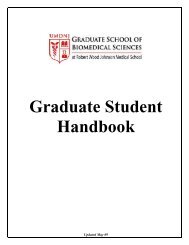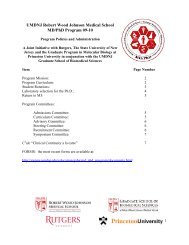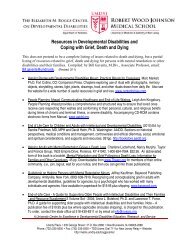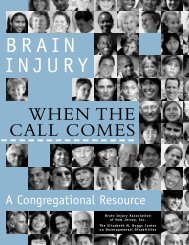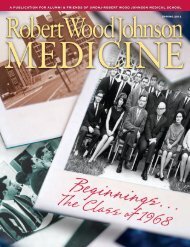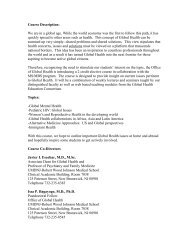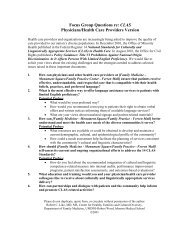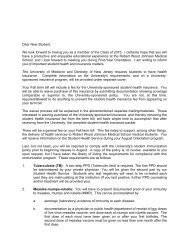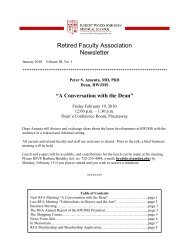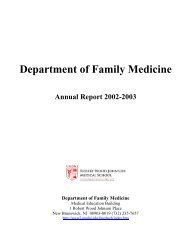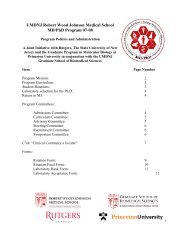Robert Wood Johnson Medicine • Spring 2011 • Population Science
Robert Wood Johnson Medicine • Spring 2011 • Population Science
Robert Wood Johnson Medicine • Spring 2011 • Population Science
Create successful ePaper yourself
Turn your PDF publications into a flip-book with our unique Google optimized e-Paper software.
Comprehensive Cancer Center, CINJ<br />
has the infrastructure, technology, and<br />
experience to handle the huge volume of<br />
data in the registry, says John J. Graff,<br />
PhD, associate professor of radiation<br />
oncology, who serves as chief of the division<br />
of cancer bioinformatics and surveillance.<br />
Dr Graff, a cancer epidemiologist,<br />
directs the Cancer Registry. In addition,<br />
he is a co-investigator on the Cancer<br />
Surveillance and Outcomes Research<br />
Team, a national consortium investigating<br />
outcomes associated with treatment,<br />
treatment decisions, and patientprovider<br />
communication in breast cancer.<br />
The NJSCR is a longtime contributor<br />
to the NCI’s Surveillance, Epidemiology<br />
and End Results (SEER) Program, a<br />
national database on cancer incidence,<br />
prevalence, survival, and mortality.<br />
SEER data are gathered from specific<br />
geographic areas representing 26 percent<br />
of the population of the United<br />
States. The NJSCR is also a contributing<br />
member of the Centers for Disease<br />
Control and Prevention’s National<br />
Program on Cancer Registries, which<br />
collects data from state-based registries<br />
representing 96 percent of the population<br />
of the United States.<br />
As one of the largest state cancer<br />
registries, the NJSCR is a sought-after<br />
resource not only for scientists doing<br />
population-based cancer research in<br />
New Jersey, but also for their colleagues<br />
across the country. New Jersey, with<br />
51,000 reported cases of cancer annually,<br />
is one of the highest rates nationwide<br />
— though not the highest. The state<br />
has a highly diverse population — 3 percent<br />
Asian American, 5 percent Hispanic,<br />
and 10 percent African American<br />
— as well as marked disparities in<br />
cancer treatment and outcomes. In addition<br />
to its diversity and rate of cancer<br />
occurrence, the state’s small geographic<br />
size and population density increase<br />
the broad usefulness of the registry.<br />
Standardized electronic medical<br />
records (EMRs), when added to the<br />
data recorded in the NJSCR, create<br />
promising synergies for cancer researchers.<br />
Starting with a patient’s original<br />
diagnosis, the standardized EMR<br />
will report in real time not only much of<br />
the information now collected on every<br />
cancer patient, but also other data not<br />
always recorded but with the potential<br />
to play a role in treatment and outcomes.<br />
From more complete data,<br />
researchers will be able to draw conclusions<br />
that will assist in targeted community<br />
education and in the application of<br />
personalized medicine, tailored to specific<br />
patients.<br />
“You can’t prevent all cancers,”<br />
says Dr. Graff, “but you can improve<br />
outcomes and give patients a better<br />
quality of life.”<br />
Outreach and<br />
Education: Research<br />
Transforming Lives<br />
<strong>Population</strong> <strong>Science</strong>:<br />
The Outreach Piece<br />
Community groups can become<br />
critical partners in research,<br />
moving an academician’s discoveries<br />
into the lives of the people<br />
they are designed to help. Sociologist<br />
Shawna V. Hudson, PhD, associate<br />
professor of family medicine and community<br />
health and director of community<br />
research, CINJ, coordinates the<br />
institute’s outreach efforts. Since joining<br />
the faculty in 2002, Dr. Hudson<br />
has participated in or led several<br />
prevention-focused population science<br />
studies, often in collaboration with Dr.<br />
Crabtree. The studies have included<br />
NIH-sponsored research, describing<br />
cancer detection and outreach in community<br />
settings and assessing how<br />
effectively primary care practices handle<br />
screenings for specific cancers.<br />
In 2008, the NIH awarded Dr.<br />
Hudson a five-year, $643,361 career<br />
development grant for diversity that<br />
focuses on early-stage cancer survivors<br />
and examines their<br />
post-treatment followup<br />
care. This research was<br />
inspired by her community<br />
collaborations with the CINJ<br />
Network hospitals and by organizations<br />
such as the Sisters Network of<br />
Central New Jersey, an African American<br />
breast cancer survivors group.<br />
Because breast cancer tends to be<br />
more aggressive in African American<br />
women, Dr. Hudson wants to understand<br />
and improve the patterns of<br />
follow-up care after cancer treatment<br />
and explore the role of primary care in<br />
that process. Her study targets the<br />
needs of various cancer survivors,<br />
including the elderly and ethnic or<br />
minority groups.<br />
In addition, Dr. Hudson is working<br />
on a survey study that will help develop<br />
follow-up interventions 10 or even 15<br />
years after treatment. “There is little<br />
research on cancer survivors in the community.<br />
It is important that we understand<br />
their needs,” says Dr. Hudson.<br />
In September, the NCI awarded a<br />
one-year, $200,000 grant to CINJ to<br />
support outreach efforts in South Asian<br />
populations. Dr. DiPaola serves as principal<br />
investigator, and Dr. Hudson<br />
directs the effort. The grant made CINJ<br />
one of 17 sites in a national network of<br />
organizations seeking to improve community<br />
education in the areas of cancer<br />
prevention, care, and outcomes.<br />
South Asian<br />
Total Health Initiative<br />
The South Asian Total Health<br />
Initiative (SATHI) was officially<br />
launched at RWJMS in 2009.<br />
A comprehensive research, education,<br />
and outreach initiative, SATHI started<br />
as a grassroots effort and soon found<br />
its home in the Department of Pediatrics.<br />
The initiative is the product of<br />
concerns about health care disparities<br />
in central New Jersey’s fast-grow-<br />
<strong>Robert</strong> <strong>Wood</strong> <strong>Johnson</strong> ■ MEDICINE 33



